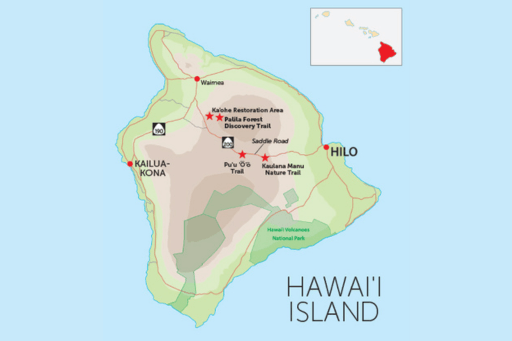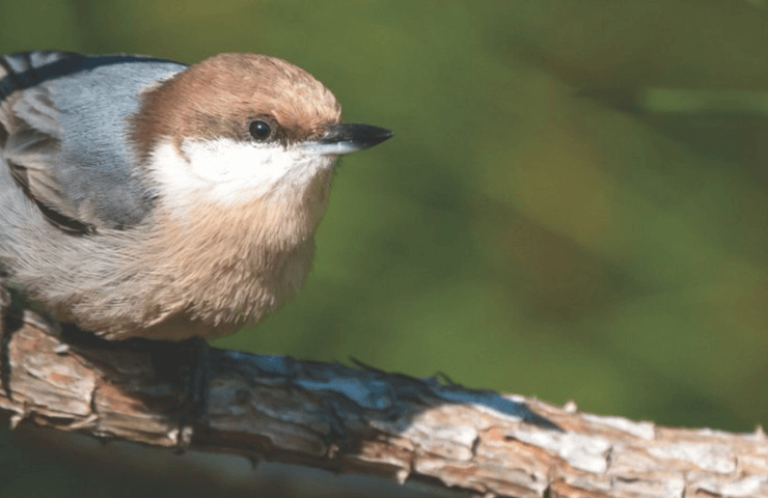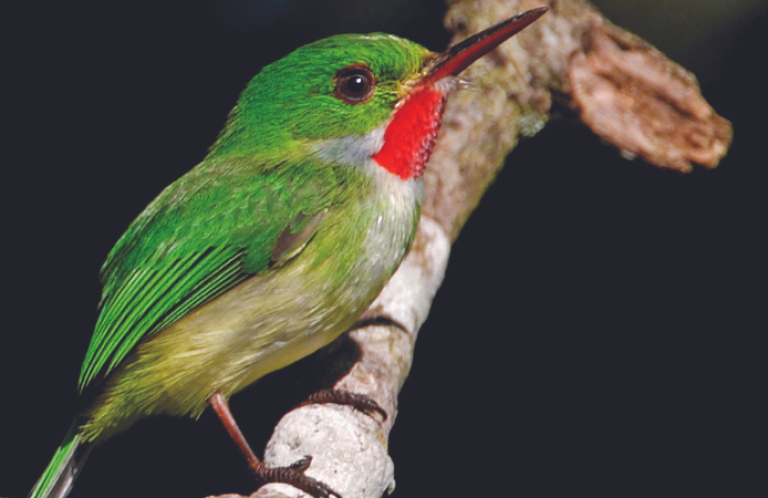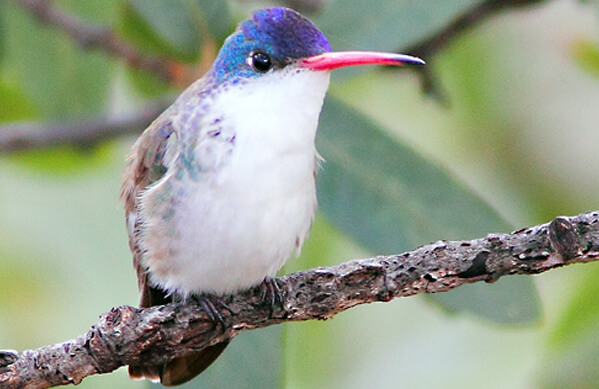ABC Birding: Palila Forest Discovery Trail, Hawai'i
Lay of the Land: Located on the island of Hawai‘i, the Mauna Kea Forest Reserve's Palila Forest Discovery Trail — designed and supported with help from American Bird Conservancy (ABC) — goes through one of the largest remaining tracts of high-elevation dry forest remaining in the state. Accessible only via four-wheel-drive vehicle, this area is home to the Critically Endangered Palila, a yellow-headed songbird with a thick black bill adapted to crack open tough pods of the Māmane tree. At around 7,300 feet, this dry area occurs above the wetter ‘Ōhi‘a and Koa forests found below.
Focal Birds: Unfortunately, the trail's namesake Palila is in steep decline. The latest count in February 2022 yielded an estimate of 678 birds remaining in the wild. Because of their scarcity, these gorgeous, melodic honeycreepers can be hard to find without dedication and perseverance. However, other native birds are likely to be seen on a visit to the trail: Hawai‘i ‘Elepaio (listen for their squeaky dog-toy calls), Hawai‘i ‘Amakihi, and if you're fortunate, Pueo, the endemic subspecies of the Short-eared Owl. Hawai‘i also hosts many introduced bird species. Those frequently seen and heard here include: Erckel's Spurfowl, California Quail, Eurasian Skylark, Japanese Bush Warbler, Warbling White-eye, and Red-billed Leiothrix.
Other Wildlife: Hawai‘i has no native amphibians or reptiles, and just one land mammal, a bat. However, many non-native mammals are now present in the area. (See “Conservation Activities” below.)
Along the trail, visitors find a series of signs pointing out natural history features and vegetation. Māmane is one of the dominant trees, with small compound leaves, bright yellow flowers, and distinctive, leathery seed pods. The other common tree in this area is Naio — which is favored by Hawai‘i ‘Elepaio. Another notable feature is the small, protected grove of an endemic sandalwood or ‘iliahi (Santalum paniculatum), renowned for its fragrant flowers and wood.
When to Visit: The trail is open year-round during the day, but requires a four-wheel-drive vehicle. Any access can prove difficult during the rainy season, from November to March. Be aware that this area is high (you might feel the altitude), dry (no smoking or parking in grass), and the surrounding areas periodically have hunters present.
Conservation Activities: Now confined to this high-altitude forest, Palila face multiple threats: Introduced sheep and goats destroy and degrade the habitat, non-native cats and mongooses kill Palila chicks and nesting adults, rats take eggs, and invasive plants hinder growth of beneficial native plants and increase fire risk. Climate change has altered the rainfall pattern, and with rising temperatures, introduced mosquitoes are moving to higher elevations on Mauna Kea. Like many of the islands' other native forest birds, Palila are highly susceptible to avian malaria transmitted by these insects. Fortunately, for now, Palila live at an elevation where mosquitoes are unable to successfully reproduce.
To improve the forest and protect Palila, ABC is working with partners in Hawai‘i like the Mauna Kea Forest Restoration Project to plant thousands of native trees each year and remove non-native predators. As part of the Birds, Not Mosquitoes initiative, we are working across the state in an urgent effort to break the avian disease cycle and protect Palila and the other honeycreepers.
Directions: From Hilo, head west on State Route 200 (Saddle Road), passing Mauna Kea Observatory and Pōhakuloa Training Area, then bear right on the road to Waiki‘i. After going up a series of small hills, there will be a sharp right turn onto an uphill dirt road and a hunter check-in station. Stay on this road, R-1, as it climbs. The large parking lot for the Palila Forest Discovery Trail will be on the left side, approximately 3.8 miles from the paved road.
From Kailua-Kona: Head north on State Route 190, then turn right onto State Route 200 heading to Waiki‘i, then turn left onto the dirt road (and follow directions above).
In the Area: On the drive west from Hilo along Saddle Road (Route 200), there are two easy-access stops where native forest songbirds can be seen and heard. At Kaulana Manu Nature Trail (22 miles west of Hilo), there is a short loop trail and the parking lot has a great vantage point looking into the canopy. This is one of the best places on the island to see the following native forest birds: ‘I‘iwi, ‘Ōma‘o, ‘Apapane, and Hawai‘i ‘Amakihi (although the Palila Forest Discovery Trail is a better place to find the latter species). West another 1.4 miles on Saddle Road lies Pu‘u ‘Ō‘ō Trail, a longer hike where, in addition to the more common native songbirds mentioned for the last trail, there is the possibility of ‘Io (Hawaiian Hawk) and also a remote chance of finding two Endangered species, ‘Akiapōlā‘au and ‘Alawī or Hawai‘i Creeper.
For more information, see: bit.ly/HIbirding





















































